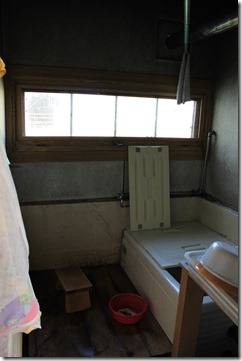Japanese Bath Time
While in Japan we have been introduced to many different traditions and customs. One big part of life here are the onsens and public baths, community places to get clean, soak and talk with your neighbors. Our friend told us, people in the bath are all equals; there are no clothes to delineate one social class from another, the conversation flows freely. With the creation indoor plumbing people don’t use the public baths as often, but they are still visited. Due to the late coming of the tub and shower in every home they are always separate from the toilet.
 At our last two farms we always used the shower and were never invited to use the tub, which seemed to be reserved for family members only. However our dairy farm host only had a true Japanese bath in their house without a shower. A traditional bathtub is shorter and deeper than common tubs back home. You are not able to fully extend your legs and the water will come up over your shoulders. Attached to the tub is a small heater that pulls in cold water from the bottom and outputs hot water in the middle. Sometimes the water can be scalding on top and yet frigid on the bottom, so it’s best to stir the water before getting in.
At our last two farms we always used the shower and were never invited to use the tub, which seemed to be reserved for family members only. However our dairy farm host only had a true Japanese bath in their house without a shower. A traditional bathtub is shorter and deeper than common tubs back home. You are not able to fully extend your legs and the water will come up over your shoulders. Attached to the tub is a small heater that pulls in cold water from the bottom and outputs hot water in the middle. Sometimes the water can be scalding on top and yet frigid on the bottom, so it’s best to stir the water before getting in.
It is also customary to not get in the tub until you are completely clean. To do this, located next to the tub is a small, wooden stool to sit on and a bucket. You dunk the bucket in to the tub for water and do all of your washing outside the tub. If you are really dirty you might even wash twice. When you are completely clean you can enter the tub and relax. Once you are done, make sure not to drain the water! The tub water is reused by the next person and then the next person until everyone has washed. The water is kept warm by covering the tub in between baths and can also be reheated if necessary.
It was difficult to get used to taking this type of bath, especially the first few days when we had 9 people all using the same bath water. However, now I kind of look forward to taking a bath.
 We travel: to learn and grow, to challenge ourselves, stretch our limits and foster an appreciation of both the world at large and our own back home.
We travel: to learn and grow, to challenge ourselves, stretch our limits and foster an appreciation of both the world at large and our own back home.
